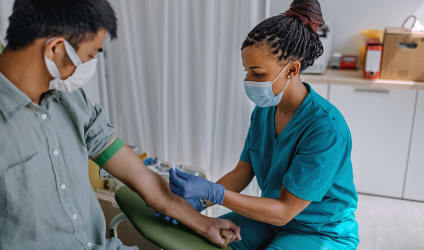How to Become a Phlebotomist
Editor & Writer
Editor
Editor & Writer
Editor
www.bestcolleges.com is an advertising-supported site. Featured or trusted partner programs and all school search, finder, or match results are for schools that compensate us. This compensation does not influence our school rankings, resource guides, or other editorially-independent information published on this site.
Turn Your Dreams Into Reality
Take our quiz and we'll do the homework for you! Compare your school matches and apply to your top choice today.
Portions of the following article were drafted using an in-house natural language generation platform. The article was then reviewed, fact-checked, and edited by multiple members of our editorial team prior to publishing.
- Phlebotomists typically need a postsecondary non-degree credential from an accredited phlebotomy program.
- Only four states require certification for phlebotomists, but many employers prefer or require the credential regardless.
- Phlebotomists must complete continuing education to maintain their certification.
Phlebotomists unlock the mysteries of the human body, one vial at a time. Sometimes referred to as phlebotomy technicians, these healthcare heroes are not just adept at drawing blood but also at performing a myriad of crucial clinical tasks, like processing specimens for lab tests, ensuring patient safety, and managing administrative duties.
It's a demanding role, but being a phlebotomist can be rewarding, too. In 2022, the top 10% of phlebotomists earned a median annual salary of $51,610, according to the Bureau of Labor Statistics (BLS). And as a healthcare worker, you have the opportunity to directly improve the lives of your patients.
So, if you're up for making a significant impact in healthcare, phlebotomy could be a great career choice for you.
Related Programs You May Be Interested In
Learn about start dates, transferring credits, availability of financial aid, and more by contacting the universities below.
3 Steps to Become a Phlebotomist
Embarking on a career in phlebotomy involves a three-step educational journey. These steps include obtaining a high school or GRE diploma, completing an accredited phlebotomy program, and earning national certification.
Step 1: Obtain a High School or GRE Diploma
Your first step towards becoming a phlebotomist is to secure a high school or a GED diploma. This paves the way for your admission into an accredited phlebotomy program, setting a strong academic base for your future studies in phlebotomy.
Step 2: Complete an Accredited Phlebotomy Program
With your diploma in hand, you can now apply to an accredited phlebotomy program. These programs typically take less than a year to complete and are widely available at community colleges, technical schools, and even at some hospitals.
Your studies will blend theoretical learning with practical training, giving you a well-rounded understanding of the role and responsibilities of a phlebotomist.
Step 3: Earn National Certification
The final step in your journey is earning national certification. Not all states require certification, but many employers prefer to hire certified individuals. Some employers may hire you without it and train you on the job, but often with the expectation that you will earn certification eventually.
There are several different agencies you can choose to be certified with, but two popular organizations that accredit phlebotomy programs are The National Accrediting Agency for Clinical Laboratory Sciences (NAACLS) and the American Society for Clinical Pathology (ASCP).
Securing certification typically involves passing a comprehensive examination, which includes both written and practical portions. The prerequisites vary depending on the certification, but most include obtaining a high school diploma and completing a phlebotomy program (or having at least one year of on-the-job experience).
Which States Require Phlebotomists to be Certified?
Currently, only four states in the U.S. — California, Nevada, Louisiana, and Washington — mandate certification for phlebotomists.
In the remaining states, certification is not legally required, but many employers prefer or even require it. So, even if you're not in a state that requires certification, earning your certification can significantly enhance your employment prospects as a phlebotomist.
What Does Phlebotomist Training Look Like?
Training to become a phlebotomist involves a combination of classroom learning and hands-on training. In the classroom, you'll learn about the human body, the circulatory system, infection control, and medical terminology.
You'll also learn about the legal and ethical considerations of phlebotomy, ensuring that you're prepared to conduct yourself professionally in the healthcare setting.
Your hands-on training will give you the opportunity to practice drawing blood, handling and processing specimens, and interacting with patients. By the time you complete your training, you'll be well-equipped to start your career as a phlebotomist.
How Long Does It Take to Become a Phlebotomist?
If you're wondering how long it takes to become a phlebotomist, the answer largely depends on the program you choose and your pace of learning. Typically, it takes less than a year to complete a phlebotomy program, although some accelerated programs can be completed in 4-8 weeks.
This includes both your classroom learning and your practical training. However, keep in mind that to become a fully certified phlebotomist, you'll also need to pass your certification exam, which might require additional study time.
Frequently Asked Questions About How to Become a Phlebotomist
What are the skills of a phlebotomist?
Some of the most important skills for phlebotomy include dexterity, attention to detail, and communication skills. Other important skills include:
- Ability to adhere to safety and infection control protocols
- Empathy and patient-care skills for dealing with patients
- Organizational skills for managing patient records and lab supplies
How much do phlebotomists make?
Phlebotomists' salaries vary significantly depending on their on-the-job experience and the industry they work in. On average, phlebotomists earned a median annual wage of $38,530 in 2022, according to the BLS.
The top industry for phlebotomists is outpatient care centers, where professionals earned a median of $42,750 in 2022. Alternatively, phlebotomists who work in ambulatory healthcare services saw the lowest median wages, at $36,190.
What are the continuing education requirements for phlebotomists?
Continuing education for phlebotomists varies by certifying body, but it typically involves completing certain hours of additional training or education to maintain certification every 2-3 years.
While certification is not mandatory in all states, many employers prefer it. In addition, being certified may improve your job prospects and earning potential. You should consult your certification organization for specific continuing education requirements.







